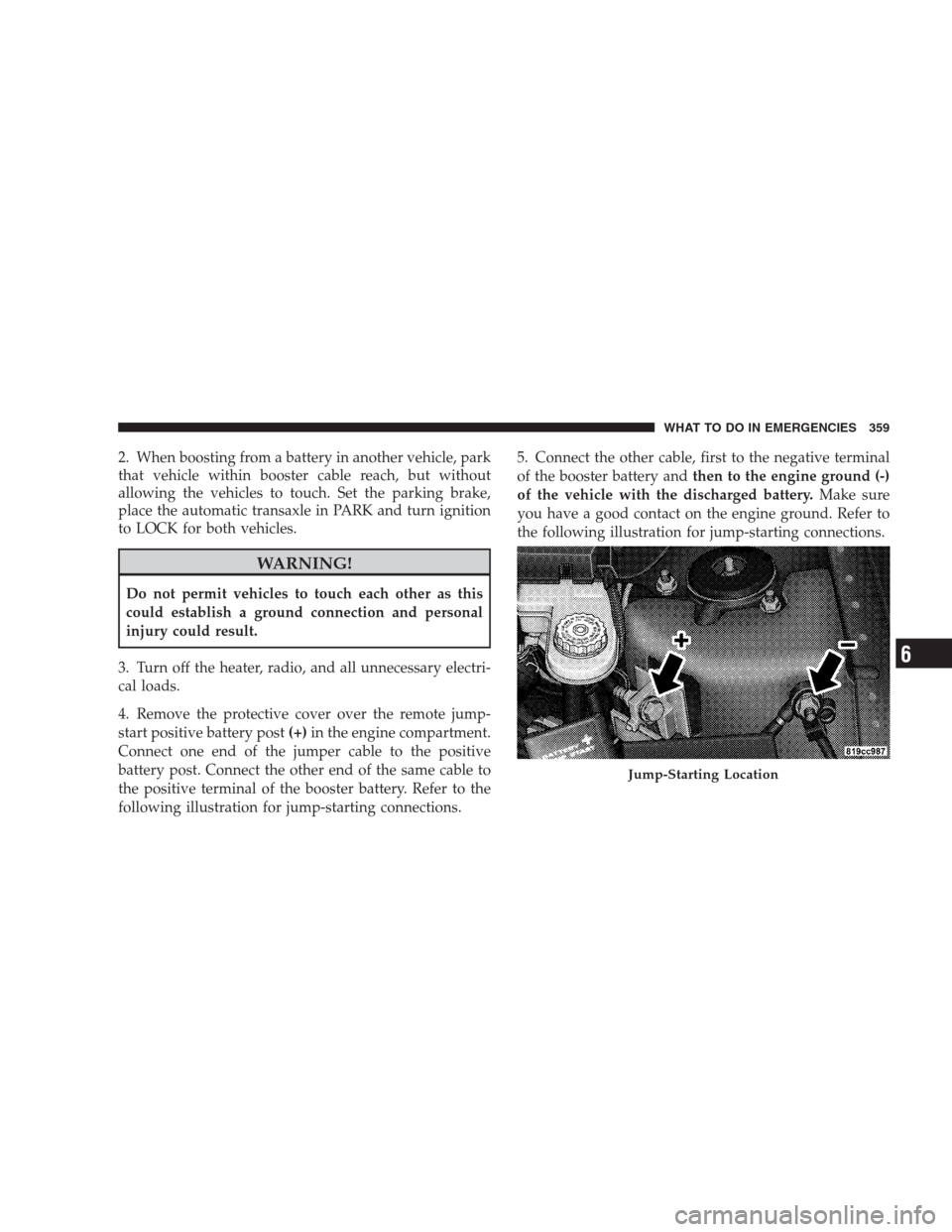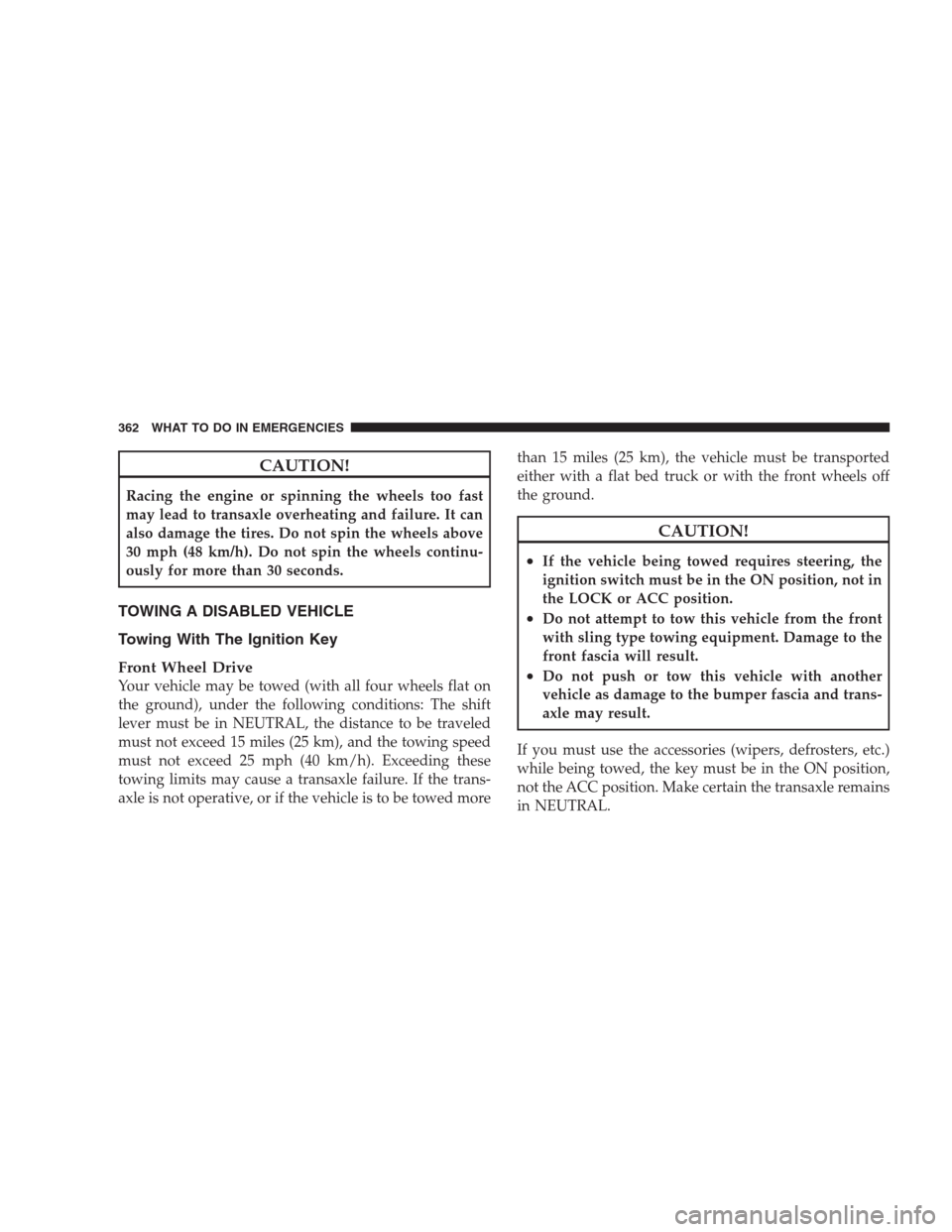Page 360 of 473

JUMP-STARTING PROCEDURE
The battery is stored between the left front headlight
assembly and the left front wheel splash shield. Access is
through the splash shield.
Jump-starting remote battery terminals are located under
the hood.
WARNING!
•Take care to avoid the radiator cooling fan when-
ever the hood is raised. It can start anytime the
ignition switch is on. You can be hurt by the fan.
(Continued)
WARNING! (Continued)
•Do not attempt to push or tow your vehicle to get
it started. Vehicles equipped with an automatic
transaxle cannot be started this way. Unburned
fuel could enter the catalytic converter and once
the engine has started, ignite and damage the
converter and vehicle. If the vehicle has a dis-
charged battery, booster cables may be used to
obtain a start from another vehicle. This type of
start can be dangerous if done improperly, so
follow this procedure carefully.
•Do not use a booster battery or any other booster
source with an output that exceeds 12-Volts.
1. Wear eye protection and remove any metal jewelry
such as watchbands or bracelets that might make an
inadvertent electrical contact.
358 WHAT TO DO IN EMERGENCIES
Page 361 of 473

2. When boosting from a battery in another vehicle, park
that vehicle within booster cable reach, but without
allowing the vehicles to touch. Set the parking brake,
place the automatic transaxle in PARK and turn ignition
to LOCK for both vehicles.
WARNING!
Do not permit vehicles to touch each other as this
could establish a ground connection and personal
injury could result.
3. Turn off the heater, radio, and all unnecessary electri-
cal loads.
4. Remove the protective cover over the remote jump-
start positive battery post(+)in the engine compartment.
Connect one end of the jumper cable to the positive
battery post. Connect the other end of the same cable to
the positive terminal of the booster battery. Refer to the
following illustration for jump-starting connections.5. Connect the other cable, first to the negative terminal
of the booster battery andthen to the engine ground (-)
of the vehicle with the discharged battery.Make sure
you have a good contact on the engine ground. Refer to
the following illustration for jump-starting connections.
Jump-Starting Location
WHAT TO DO IN EMERGENCIES 359
6
Page 362 of 473

6. If the vehicle is equipped with Sentry Key�Immobi-
lizer, turn the ignition switch to the ON position for three
seconds before moving the ignition switch to the START
position.
7. Start the engine in the vehicle that has the booster
battery, let the engine idle a few minutes, and then start
the engine in the vehicle with the discharged battery.
8. When removing the jumper cables, reverse the se-
quence exactly. Be careful of the moving belts and fan.
9. Reinstall the protective cover over the remote jump-
start positive battery post.WARNING!
During cold weather when temperatures are below
freezing point, electrolyte in a discharged battery
may freeze. Do not attempt jump-starting because
the battery could rupture or explode. The battery
temperature must be brought up above the freezing
point before attempting a jump-start.
NOTE:Refer to “Maintenance Procedures” in Section 7
of this manual for information on accessing the battery
for service or replacement.
WARNING!
Any procedure other than above could result in:
•Personal injury caused by electrolyte squirting out
the battery vent;
(Continued)
360 WHAT TO DO IN EMERGENCIES
Page 364 of 473

CAUTION!
Racing the engine or spinning the wheels too fast
may lead to transaxle overheating and failure. It can
also damage the tires. Do not spin the wheels above
30 mph (48 km/h). Do not spin the wheels continu-
ously for more than 30 seconds.
TOWING A DISABLED VEHICLE
Towing With The Ignition Key
Front Wheel Drive
Your vehicle may be towed (with all four wheels flat on
the ground), under the following conditions: The shift
lever must be in NEUTRAL, the distance to be traveled
must not exceed 15 miles (25 km), and the towing speed
must not exceed 25 mph (40 km/h). Exceeding these
towing limits may cause a transaxle failure. If the trans-
axle is not operative, or if the vehicle is to be towed morethan 15 miles (25 km), the vehicle must be transported
either with a flat bed truck or with the front wheels off
the ground.
CAUTION!
•If the vehicle being towed requires steering, the
ignition switch must be in the ON position, not in
the LOCK or ACC position.
•Do not attempt to tow this vehicle from the front
with sling type towing equipment. Damage to the
front fascia will result.
•Do not push or tow this vehicle with another
vehicle as damage to the bumper fascia and trans-
axle may result.
If you must use the accessories (wipers, defrosters, etc.)
while being towed, the key must be in the ON position,
not the ACC position. Make certain the transaxle remains
in NEUTRAL.
362 WHAT TO DO IN EMERGENCIES
Page 367 of 473
MAINTAINING YOUR VEHICLE
CONTENTS
�Engine Compartment — 2.4L............. 367
�Engine Compartment — 2.7L............. 368
�Engine Compartment — 3.5L............. 369
�Onboard Diagnostic System — OBD II....... 370
▫Loose Fuel Filler Cap Message........... 370
�Emissions Inspection And Maintenance
Programs............................ 371
�Replacement Parts..................... 372
�Dealer Service........................ 373�Maintenance Procedures................. 373
▫Engine Oil......................... 373
▫Engine Oil Filter..................... 377
▫Engine Air Cleaner Filter............... 377
▫Maintenance-Free Battery............... 378
▫Air Conditioner Maintenance............ 379
▫A/C Air Filter — If Equipped............ 380
▫Body Lubrication..................... 381
▫Windshield Wiper Blades............... 382
7
Page 368 of 473
▫Adding Washer Fluid.................. 382
▫Exhaust System...................... 383
▫Cooling System...................... 385
▫Brake System....................... 390
▫Automatic Transaxle.................. 392
▫Appearance Care And Protection From
Corrosion.......................... 395
▫Cleaning Center Console Cupholders...... 400
�Fuses.............................. 400
▫Totally Integrated Power Module (TIPM).... 400
�Vehicle Storage....................... 409�Replacement Bulbs..................... 409
�Bulb Replacement..................... 410
▫Headlight.......................... 410
▫Fog Lights......................... 412
▫Taillights, Rear Turn Signals And Backup
Lights............................. 413
▫License Plate Light................... 415
▫Center High-Mounted Stop Light......... 415
�Fluids And Capacities................... 417
�Fluids, Lubricants, And Genuine Parts....... 418
▫Engine............................ 418
366 MAINTAINING YOUR VEHICLE
Page 369 of 473
ENGINE COMPARTMENT — 2.4L
1 — Engine Coolant Reservoir 7 — Air Cleaner Filter
2 — Power Steering Fluid Reservoir 8 — Engine Oil Fill
3 — Automatic Transaxle Dipstick 9 — Coolant Pressure Cap
4 — Brake Fluid Reservoir 10 — Engine Oil Dipstick
5 — Integrated Power Module 11 — Washer Fluid Reservoir
6 — Power Distribution CenterMAINTAINING YOUR VEHICLE 3677
Page 370 of 473
ENGINE COMPARTMENT — 2.7L
1 — Engine Coolant Reservoir 7 — Power Distribution Center
2 — Coolant Pressure Cap 8 — Air Cleaner Filter
3 — Power Steering Fluid Reservoir 9 — Engine Oil Dipstick
4 — Automatic Transaxle Dipstick 10 — Engine Oil Fill
5 — Brake Fluid Reservoir 11 — Washer Fluid Reservoir
6 — Integrated Power Module 368 MAINTAINING YOUR VEHICLE